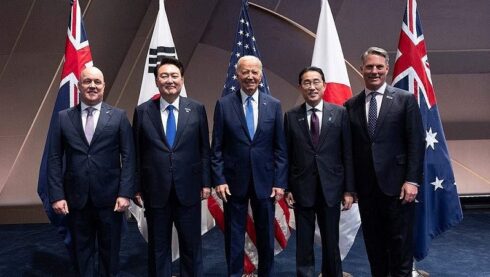Written by Ahmed Adel, Cairo-based geopolitics and political economy researcher
The NATO summit in Washington demonstrated the bloc’s desire to expand its activities to the Asia-Pacific region, which is why the leaders of Japan, South Korea, New Zealand, and Australia were invited to attend the event. In fact, this is the third time they have participated at the highest level in the alliance’s top officials meeting and the third time the military bloc declared its intention to develop partnerships with these countries.
NATO’s increased focus on the Asia-Pacific region is a relatively new phenomenon. Founded 75 years ago as an alliance of the United States and several European countries to provide security against the “Soviet threat” on the European continent, the bloc’s founding documents state that its area of operations borders the northern part of the Atlantic Ocean, a region very far from the Asia-Pacific.
As the US increasingly confronts China, NATO leaders also encourage cooperation with Asian-Pacific countries. In 2022, NATO leaders called China a “potential threat” and began expanding military ties with countries in the region, mainly with US allies—Japan, South Korea, Australia, and New Zealand.
The Washington Summit (July 9-11) described China as a “decisive enabler” of Russia’s military efforts in Ukraine, noting that Beijing poses a “systemic challenge to European security” through its “no-limits partnership.”
Chinese spokesperson Lin Jian hit back at the accusation, saying, “NATO hyping up China’s responsibility on the Ukraine issue is unreasonable and has sinister motives,” and added that China has a fair and objective stance on the Ukraine issue.
NATO Secretary General Stoltenberg said China was challenging the bloc in Europe, Africa, the Arctic, and elsewhere. The alliance’s fears of China’s growing dominance are shared by the current leaders of Japan, South Korea, Australia, and New Zealand, who are willing to cooperate with the Western military power bloc. For this reason, at the summit in Washington, these countries were asked to cooperate on four issues: Ukraine, artificial intelligence, disinformation, and cybersecurity.
Now, according to information leaked in the press, NATO warships from Britain, Germany, France, and the Netherlands, along with US ships, will regularly appear in the Pacific.
It is recalled that the term “Asian NATO” was coined by Chinese media. This is how Beijing reacted to the creation of QUAD, which includes the United States, Australia, Japan, and India. However, this association has no clear organizational structure or permanent secretariat, and its areas of activity have very little in common with NATO. Another alliance founded by the United States, the United Kingdom and Australia, AUKUS, has more clear military characteristics but is not as powerful as NATO.
The most important detail of the NATO alliance is the mutual defence article, which is used if any member state is attacked. In this way, the real danger for the people of Southeast Asia is not QUAD or AUKUS but the presence of NATO warships in the Western Pacific and NATO’s defence cooperation with countries in the region. Obviously, these warships are all aimed at China and Russia, but if an armed conflict breaks out, the small countries in Asia will be caught in the crossfire, a scenario they want to avoid.
In fact, Russian President Vladimir Putin, during his two-day trip to North Korea and Vietnam in June, accused NATO of creating a security threat for Russia and other Asian countries.
“We see what is happening in Asia: a bloc system is being put together. NATO is already ‘moving’ there (to Asia) as if to a permanent place of residence. This, of course, creates a threat to all countries in the region, including the Russian Federation. We are obliged to respond to this and will do it,” Putin said.
Along with the establishment of QUAD and AUKUS, Washington has also established a trilateral security cooperation system with Japan and the Philippines and the US-Japan-South Korea trilateral military bloc that can engage in military actions against other Asian countries.
Therefore, Washington’s intentions are evident: the militarization of the Asia-Pacific region.
For this reason, Lin stressed: “China urges NATO to … stop interfering in China’s internal politics and smearing China’s image and not create chaos in the Asia-Pacific after creating turmoil in Europe.”
In the same way that US-led NATO continually expanded towards Russia and even had the audacity to progress Georgia’s and Ukraine’s membership ambitions, Washington is now creating a web of alliances in Asia-Pacific, all with the aim of containing China and Russia in the region. Beijing justifiably believes that US-led military alliances can create a situation that will descend into chaos, as has happened in Eastern Europe, and desperately wants to avoid such a scenario, even if NATO is determined to escalate the situation.
MORE ON THE TOPIC:






